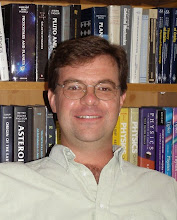 On 27 January 2010, the Cassini spacecraft acquired this close-up view of the small 60km Saturnian satellite Prometheus. Shadows cast by its irregular surface suggests that this satellite might have the `flying saucer' shape that is also exhibited by Saturn's other small satellites Pan and Atlas (as detailed in Porco et al 2007). Note that this peculiar shape can result when a satellite forms while orbiting inside a dense planetary ring (such as perhaps Pan, which does orbit in Saturn's main A ring) while also under the influence of Saturn's strong gravitational tide. This in turn suggests that Prometheus (as well as its cohorts Atlas and Pandora) might actually have formed at the outer edge of the A ring and then migrated to its current position just beyond the A ring's outer edge. This kind of radial migration is in fact expected to be driven by the strong gravitational torques that the A ring exerts on the nearby satellites. Check the CICLOPS website for more details.
On 27 January 2010, the Cassini spacecraft acquired this close-up view of the small 60km Saturnian satellite Prometheus. Shadows cast by its irregular surface suggests that this satellite might have the `flying saucer' shape that is also exhibited by Saturn's other small satellites Pan and Atlas (as detailed in Porco et al 2007). Note that this peculiar shape can result when a satellite forms while orbiting inside a dense planetary ring (such as perhaps Pan, which does orbit in Saturn's main A ring) while also under the influence of Saturn's strong gravitational tide. This in turn suggests that Prometheus (as well as its cohorts Atlas and Pandora) might actually have formed at the outer edge of the A ring and then migrated to its current position just beyond the A ring's outer edge. This kind of radial migration is in fact expected to be driven by the strong gravitational torques that the A ring exerts on the nearby satellites. Check the CICLOPS website for more details.
Thursday April 18 to Thursday April 25
2 days ago

